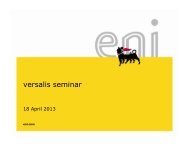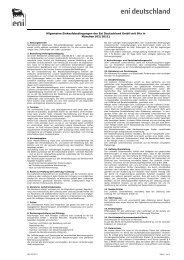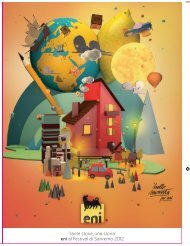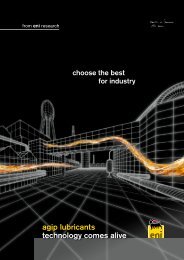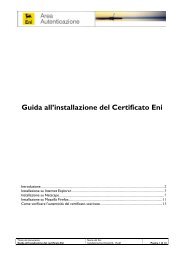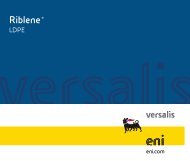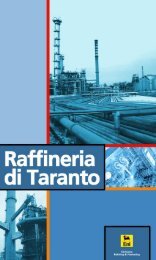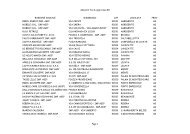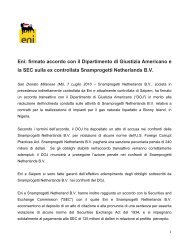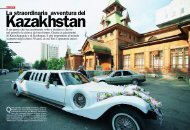È in corso il restauro conservativo del Duomo di Milano. Un ... - Eni
È in corso il restauro conservativo del Duomo di Milano. Un ... - Eni
È in corso il restauro conservativo del Duomo di Milano. Un ... - Eni
You also want an ePaper? Increase the reach of your titles
YUMPU automatically turns print PDFs into web optimized ePapers that Google loves.
FOCUS<br />
scursione termica. E anche quest’ultima<br />
non è <strong>di</strong> poco conto visto che sulla<br />
facciata <strong>del</strong> <strong>Duomo</strong> d’estate si arriva<br />
f<strong>in</strong>o a + 60° mentre durante l’<strong>in</strong>verno<br />
si possono raggiungere anche i -20°”.<br />
Per fortuna, la Veneranda Fabbrica<br />
<strong>del</strong> <strong>Duomo</strong> non ha problemi per approvvigionarsi<br />
<strong>del</strong>la “materia prima”.<br />
Da oltre sei secoli può ricavare <strong>il</strong> marmo<br />
<strong>di</strong>rettamente dalle Cave <strong>di</strong> Candoglia,<br />
nella bassa Val d’Ossola, <strong>di</strong> cui è<br />
proprietaria dal 1387 per volontà <strong>di</strong><br />
Gian Galeazzo Visconti, allora Signore<br />
<strong>di</strong> M<strong>il</strong>ano. Proprietà poi riba<strong>di</strong>ta <strong>in</strong><br />
epoca più recente da re Vittorio Emanuele<br />
III <strong>di</strong> cui si scopre oggi, curiosamente,<br />
a circa trenta metri da terra,<br />
sul fianco destro <strong>del</strong>la facciata <strong>del</strong><br />
<strong>Duomo</strong>, <strong>il</strong> volto <strong>in</strong> bassor<strong>il</strong>ievo contrapposto<br />
a quello <strong>di</strong> Benito Mussol<strong>in</strong>i<br />
che era <strong>il</strong> capo <strong>del</strong> governo <strong>del</strong>l’epoca.<br />
Forse anche una traccia <strong>del</strong> <strong>restauro</strong><br />
<strong>del</strong>la Cattedrale <strong>di</strong> M<strong>il</strong>ano compiuto<br />
fra <strong>il</strong> 1935 e <strong>il</strong> 1939. Ma “contam<strong>in</strong>azioni”<br />
<strong>del</strong> genere, assicurano, non sono<br />
state mai più effettuate.<br />
Oltre alle cave, la Veneranda Fabbrica<br />
<strong>del</strong> <strong>Duomo</strong> <strong>di</strong>spone anche <strong>di</strong> un proprio<br />
Cantiere Marmisti per la lavorazione <strong>di</strong> questa pietra<br />
tanto bella quanto <strong>del</strong>icata e <strong>del</strong>la collaborazione <strong>di</strong> operai<br />
quadratori, ornanisti e anche, naturalmente, <strong>di</strong> esperti scultori.<br />
Questa struttura è <strong>in</strong><strong>di</strong>spensab<strong>il</strong>e perché la “sopravvivenza”<br />
<strong>del</strong> marmo <strong>di</strong> Candoglia “<strong>in</strong> buona salute” è relativamente<br />
breve.<br />
“Ogni trenta anni, <strong>in</strong> me<strong>di</strong>a, è necessario fare <strong>in</strong>terventi conservativi<br />
tipo quello che stiamo compiendo ora” spiega l’<strong>in</strong>gegner<br />
Mörl<strong>in</strong> Visconti Castiglione mentre sulle impalcature<br />
<strong>del</strong>la facciata <strong>del</strong> <strong>Duomo</strong> <strong>di</strong> M<strong>il</strong>ano, ad una altezza <strong>di</strong> circa<br />
24<br />
quaranta metri, guida ad una visita dei lavori. “Infatti era stato<br />
fra <strong>il</strong> 1972 e <strong>il</strong> 1974 che si era precedentemente <strong>in</strong>tervenuti.<br />
Ma oggi, grazie alle opportunità offerte da queste nuove<br />
tecnologie si può procedere ad una verifica e ad un riprist<strong>in</strong>o<br />
certamente più significativi”.<br />
Sono già cento<strong>di</strong>ecim<strong>il</strong>a le ore <strong>di</strong> lavoro che, dal 2003 ad oggi,<br />
hanno compiuto i c<strong>in</strong>quanta dei 128 <strong>di</strong>pendenti <strong>del</strong>la Veneranda<br />
Fabbrica <strong>del</strong> <strong>Duomo</strong> impegnati sull’impalcatura <strong>del</strong>la<br />
facciata (altre c<strong>in</strong>quantam<strong>il</strong>a ore sono state impiegate nella<br />
cava per estrarre <strong>il</strong> marmo e poi lavorarlo per prepararlo alle<br />
esigenze <strong>del</strong> <strong>restauro</strong>). E non è davvero semplice<br />
lavorare a dec<strong>in</strong>e <strong>di</strong> metri <strong>di</strong> altezza, operare, per<br />
esempio, con un argano per togliere una statua <strong>di</strong><br />
marmo degradata e sostituirla con una sua copia.<br />
Procedura altrettanto lenta, faticosa e complessa<br />
è sostituire qualsiasi altro elemento o una semplice<br />
lastra <strong>di</strong> copertura <strong>del</strong>la facciata.<br />
“Ma <strong>in</strong> questi trapianti non abbiamo per fortuna<br />
problemi <strong>di</strong> rigetto” scherza l’<strong>in</strong>gegner Mörl<strong>in</strong> Visconti<br />
Castiglione, “a marmo <strong>di</strong> Candoglia sostituiamo<br />
lo stesso marmo <strong>di</strong> Candoglia... E per proteggere<br />
<strong>il</strong> nuovo marmo dal degrado ci preoccupiamo<br />
anche <strong>di</strong> quanto possono causare i piccioni.<br />
Con l’occasione <strong>di</strong> questi lavori, stiamo proteggendo<br />
tutti gli elementi scultorei con dei f<strong>il</strong>i su<br />
cui passa ciclicamente un impulso elettrico <strong>in</strong><br />
grado <strong>di</strong> produrre una fasti<strong>di</strong>osa scossa elettrica<br />
per scacciare i volat<strong>il</strong>i che vi si appoggiassero.”<br />
Luciano Simonelli è giornalista professionista,<br />
scrittore ed e<strong>di</strong>tore, collaboratore <strong>del</strong> quoti<strong>di</strong>ano<br />
“La Stampa-TuttoScienze”.<br />
<strong>Eni</strong>’s Way<br />
façade has been cleaned (us<strong>in</strong>g atomized water and<br />
micro-sand<strong>in</strong>g), for an overall surface area of 14,000 square<br />
metres. Also the restoration of twelve spires and six tracery<br />
panels has been completed, along with some 30 percent of<br />
the entire façade.<br />
A total of 1,362 pieces were replaced with new ones <strong>in</strong><br />
Candoglia marble, and of course the orig<strong>in</strong>als of statues,<br />
heads and high-reliefs are <strong>in</strong>tended for the <strong>Duomo</strong> Museum.<br />
“Candoglia marble is magnificent stone”, notes Benigno<br />
Mörl<strong>in</strong> Visconti Castiglione from beh<strong>in</strong>d his unusually long,<br />
n<strong>in</strong>eteenth-century moustache, “but has the problem of its<br />
be<strong>in</strong>g calcium carbonate, and therefore eas<strong>il</strong>y damaged by<br />
pollution as well as temperature variations”. And the latter is<br />
no little matter, as the <strong>Duomo</strong>’s façade can hit 60 degrees<br />
Centigrade <strong>in</strong> summer and m<strong>in</strong>us 20 <strong>in</strong> w<strong>in</strong>ter”.<br />
Fortunately, the Veneranda Fabbrica <strong>del</strong> <strong>Duomo</strong> doesn’t have<br />
any problems gett<strong>in</strong>g its hands on “raw material”. For over<br />
six centuries, it has been able to <strong>di</strong>g the marble <strong>di</strong>rectly from<br />
the Candoglia quarries, <strong>in</strong> the lower Val d’Ossola, it has<br />
owned s<strong>in</strong>ce 1387 thanks to Gian Galeazzo Visconti, then<br />
Lord of M<strong>il</strong>an. Ownership confirmed more recently by K<strong>in</strong>g of<br />
Italy Victor Emanuel III, whose features, curiously enough,<br />
can be seen today some 30 meters above ground <strong>in</strong> a<br />
bas-relief fac<strong>in</strong>g one of Benito Mussol<strong>in</strong>i, who was then head<br />
of government, on the right side of the <strong>Duomo</strong>’s façade.<br />
Perhaps this is also a memory of the restoration of M<strong>il</strong>an’s<br />
cathedral carried out from 1935 to 1939. But<br />
“contam<strong>in</strong>ations” of this k<strong>in</strong>d, assuredly, were never s<strong>in</strong>ce<br />
<strong>in</strong>troduced.<br />
In ad<strong>di</strong>tion to the quarries, the Veneranda Fabbrica <strong>del</strong><br />
<strong>Duomo</strong> also has its own marble cutt<strong>in</strong>g workshop to handle<br />
this stone which is as beautiful as it is <strong>del</strong>icate, and can rely<br />
<strong>Eni</strong>’s Way<br />
LE TECNOLOGIE A DISPOSIZIONE. Per i lavori sulla facciata <strong>del</strong> <strong>Duomo</strong> sono state ut<strong>il</strong>izzate tecnologie <strong>Eni</strong><br />
<strong>di</strong> <strong>in</strong>dag<strong>in</strong>e non <strong>di</strong>struttive come la termografia <strong>in</strong>frarossa per controllare l’adesione e <strong>il</strong> degrado<br />
<strong>del</strong>le stuccature che sig<strong>il</strong>lano i blocchi <strong>di</strong> pietra; la spettrometria a fluorescenza a raggi X per stu<strong>di</strong>are<br />
<strong>il</strong> degrado <strong>del</strong>la pietra e analizzare le alterazioni chimiche e microstrutturali <strong>del</strong> marmo; <strong>il</strong> georadar<br />
che penetra virtualmente la facciata e le sua fondamenta per verificarne lo stato <strong>di</strong> salute.<br />
AVAILABLE TECHNOLOGIES. For the restoration of the <strong>Duomo</strong> facade they made use of <strong>Eni</strong> non-destructive<br />
survey<strong>in</strong>g technologies such as <strong>in</strong>fra-red thermography to check the adhesion and decay of the putties seal<strong>in</strong>g<br />
the stone blocks; X-ray fluorescence spectrometry to study stone decay and analyse chemical<br />
and microstructural change of the marble; georadar, which virtually penetrates <strong>in</strong>to the façade and its foundations<br />
to check its con<strong>di</strong>tion.<br />
on the assistance of marble workers and sk<strong>il</strong>led sculptors.<br />
This structure is <strong>in</strong><strong>di</strong>spensable because Candoglia marble’s<br />
life “<strong>in</strong> good health” is relatively short.<br />
“Every thirty years, on average, it is necessary to undertake<br />
conservation work such as the one we are <strong>in</strong>volved <strong>in</strong> now”<br />
expla<strong>in</strong>ed the eng<strong>in</strong>eer Mörl<strong>in</strong> Visconti Castiglione wh<strong>il</strong>e he<br />
guided a visit to the works on the scaffold<strong>in</strong>g of the façade<br />
of the <strong>Duomo</strong>, some forty metres above ground. “Previous<br />
work dates back to 1972 to 1974. But today, thanks to the<br />
opportunities offered by these new technologies, we can<br />
carry out controls and repairs <strong>in</strong> a more significant manner”.<br />
One hundred and ten thousand work<strong>in</strong>g hours s<strong>in</strong>ce 2003<br />
have been spent by 50 people (out of the 128 employees of<br />
the Veneranda Fabbrica <strong>del</strong> <strong>Duomo</strong>) work<strong>in</strong>g on the facade<br />
scaffold<strong>in</strong>g (fifty thousand more hours have been spent <strong>in</strong> the<br />
quarries to <strong>di</strong>g the marble and then cut it to get it ready for<br />
restoration needs). And it is no easy task work<strong>in</strong>g dozens of<br />
metres off the ground, for example, with a w<strong>in</strong>ch to lift a<br />
damaged marble statue and replaced it with a copy. An equally<br />
slow, tir<strong>in</strong>g and complex process is that of replac<strong>in</strong>g all other<br />
elements or even just a slab of the façade.<br />
“But <strong>in</strong> these ‘transplants’ we fortunately have no rejection<br />
problems,” jokes the eng<strong>in</strong>eer Mörl<strong>in</strong> Visconti Castiglione,<br />
“for we are replac<strong>in</strong>g Candoglia marble with Candoglia<br />
marble... And to protect the new marble from decay we are<br />
also worry<strong>in</strong>g about the harm pigeons can <strong>in</strong>flict. With these<br />
works, we are protect<strong>in</strong>g all the sculptural elements with wires<br />
<strong>in</strong>termittently run through by an electric impulse produc<strong>in</strong>g an<br />
irritat<strong>in</strong>g electric shock to scare away any birds”.<br />
Luciano Simonelli is a journalist, author and publisher, and<br />
a contributor to the da<strong>il</strong>y “La Stampa-TuttoScienze”.<br />
25



